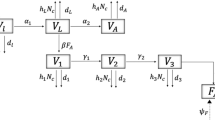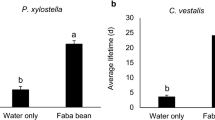Abstract
Mature female Queensland fruit flies, Bactrocera tryoni Froggatt, released into canopies of field-caged trees containing host fruit, did not discriminate between fruit having or lacking two resident conspecific females when selecting fruit on which to alight. When released individually onto a fruit, mature females showed no greater or lesser propensity to initiate boring with the ovipositor into fruit having or lacking a resident female engaged in pre-ovipositional or post-ovipositional behavior. However, boring propensity of introduced females was significantly enhanced or facilitated when released onto fruit on which a conspecific female was in the act of ovipositing. Introduced females were significantly more prone to initiate boring into high-ranking fruit (nectarines) than low-ranking fruit (lemons) and to do so when having a high rather than a low egg load. Neither fruit type nor egg load of introduced females had a significant effect on the occurrence of encounters between introduced and resident females, on the occurrence of contests, or on the propensity of introduced females to initiate boring in the presence of a resident female. Among introduced females, there was a consistent trend to initiate boring earlier in the presence than in the absence of a resident female. We discuss circumstances, likely to be narrow, under which boring propensity of an intruding female might be facilitated in the presence of a resident female.
Similar content being viewed by others
REFERENCES
Barton Browne, L. (1993). Physiologically induced changes in resource-oriented behavior. Annu. Rev. Entomol. 38: 1–25.
Bernays, E. A., and Chapman, R. F. (1994). Host Plant Selection by Phytophagous Insects, Chapman and Hall, New York.
Borden, J. H. (1982). Aggregation pheromones. In Mitton, J. B., and Sturgeon, K. M. (eds.), Bark Beetles in North American Conifers: A System for the Study of Evolutionary Biology. University of Texas Press, Austin, TX, pp. 74–139.
Calloway, R. M., and Walker, L. R. (1997). Competition and facilitation: a synthetic approach to interactions in plant communities. Ecology 78: 1958–1965.
Clayton, D. A. (1978). Socially facilitated behavior. Quart. Rev. Biol. 53: 373–392.
Collins, R. D., and Bell, W. J. (1996). Enhancement of resource finding efficiency by visual stimuli in Musca domestica. J. Kansas Ent. Soc. 69: 204–207.
Dougherty, M., and Hamilton, G. (1997). Dodecanoic acid is the oviposition pheromone of Lutzomyia longipilus. J. Chem. Ecol. 23: 2657–2671.
Drew, R. A. I. (1989). The tropical fruit flies (Diptera: Tephritidae: Dacinae) of the Australian Oceanic regions. Mem. Queensland Museum 26: 1–521.
Eismann, C. H., and Rice, M. J. (1985). Oviposition behavior of Dacus tryoni: the effects of some sugars and salts. Entomol. Exp. Appl. 39: 61–71.
Fitt, G. P. (1984). Oviposition behavior of two tephritid fruit flies, Dacus tryoni and Dacus jarvise, as influenced by the presence of larvae in the host fruit. Oecologia 62: 37–46.
Fitt, G. P. (1989). The role of interspecific interactions in the dynamics of tephritid populations. In: Robinson, A. S., and Hooper, G. (eds.), Fruit Flies: Their Biology, Natural Enemies and Control. Elsevier, Amsterdam, pp. 281–301.
Fletcher, B. S. (1987). The biology of dacine fruit flies. Annu. Rev. Entomol. 32: 115–144.
Fowler, H. G. (1992). Social facilitation during foraging in Agelaia (Hymenoptera: Vespidae). Naturwissenschaften 79: 424.
Guerin, B. (1993). Social Facilitation. Cambridge University Press, Cambridge, England.
Hill, A. R., and Hooper, G. H. S. (1984). Attractiveness of various colors to Australian tephritid fruit flies in the field. Entomol. Exp. Appl. 356: 119–128.
Holmgren, M., Scheffer, M., and Huston, M. A. (1997). The interplay of facilitation and competition in plant communities. Ecology 78: 1966–1975.
Kidd, N. A. C. (1976). Aggregation in the lime aphid (Eucalipterus tiliae). 2. Social aggregation, Oecologia 25: 175–185.
Mayhew, P. J. (1997). Adaptive patterns of host-plant selection by phytophagous insects. Oikos 79: 417–428.
McCall, P. J., Wilson, M. D., Dueben, B. D., Bronsvoort, B. M., and Health, R. R. (1997). Similarity in oviposition aggregation pheromone composition within the Simulium damnosum species complex. Bull. Entomol. Res. 87: 609–616.
Michaud, J. P. (1999). Aggregation by alatae of Toxoptera citricid. Environ. Entomol. 28: 205–2111.
Miller, J. R., and Strickler, K. L. (1984). Finding and accepting host plants. In: Bell, W. J., and Carde, R. T. (eds.), Chemical Ecology of Insects. Chapman and Hall, New York, pp. 128–157.
Miller, D. M., Koehler, P. G., and Patterson, R. S. (1997). Use of German cockroach fecal extract to enhance toxic bait performance in the presence of altenative food sources. J. Econ. Entomol. 90: 483–487.
Papaj, D. R., and Messing, R. H. (1998). Asymmetries in dynamical state as a possible explanation for resident advantage in contests. Behavior 135: 1013–1030.
Papaj, D. R., Hendrichs, J., and Katsoyannos, B. (1989). Use of fruit wounds in oviposition by the Mediterranean fruit fly. Entomol. Exp. Appl. 53: 203–209.
Pritchard, G. (1969). The ecology of a natural population of Queensland fruit fly, Dacus tryoni. II. The distribution of eggs and its relation to behavior. Aust. J. Zool. 17: 293–311.
Prokopy, R. J., and Duan, J. J. (1998). Socially facilitated egglaying behavior in Mediterranean fruit flies. Behav. Ecol. Sociobiol. 42: 117–122.
Prokopy, R. J., and Fletcher, B. S. (1987). The role of adult learning in the acceptance of host fruit for egglaying by the Queensland fruit fly, Dacus tryoni. Entomol. Exp. Appl. 45: 259–263.
Prokopy, R. J., and Reynolds, A. H. (1998). Ovipositional enhancement through socially facilitated behavior in Rhagoletis pomonella flies. Entomol. Exp. Appl. 86: 281–286.
Prokopy, R. J., Roitberg, B. D., and Averill, A. L. (1984). Resource partitioning. In: Bell, W. J. and Carde, R. T. (eds.), Chemical Ecology of Insects. Chapman and Hall, New York, pp. 301–330.
Prokopy, R. J., Drew, R. A. I., Sabine, B. N. E., Lloyd, A. C., and Hamacek, E. (1991). Effect of physiological and experiential state of Bactrocera tryoni flies intra-tree foraging behavior for food (bacteria) and host fruit. Oecologia 87: 394–400.
Prokopy, R. J., Roitberg, B. D., and Vargas, R. I. (1994). Effects of egg load on finding and acceptance of host fruit in Ceratitis capitata flies. Physiol. Entomol. 19: 124–132.
Reid, B. L., McDonald, J. F., and Ross, D. R. (1995). Foraging and spatial dispersion in protein-scavenging workers of Vespula germanica and V. maculifrons. J. Insect Behav. 8: 315–329.
Robertson, I. C., Roitberg, B. D., Williamson, I., and Senger, S. E. (1995). Contextual chemical ecology: an evolutionary approach to the chemical ecology of insects. Amer. Entomol. 41: 237–239.
Spivak, M., Conlon, D., and Bell, W. J. (1991). Wind-guided landing and search behavior in fleshflies and blowflies exploiting a resource patch. Ann. Entomol. Soc. Amer. 84: 447–452.
van Alphen, J. J. M., Visser, M. E., and Nell, H. W. (1992). Adaptive superparasitism and patch time allocation in solitary parasitoids: searching in groups vs. sequential patch visits. Behav. Ecol. Sociobiol. 6: 528–535.
Visser, M. E. (1995). The effect of competition on oviposition decisions of Leptopilina heterotoma. Anim. Behav. 49: 1677–1687.
Visser, M. E., and Rosenheim, J. A. (1998). The influence of competition between foragers on clutch size decisions in insect parasitoids. Behav. Ecol. 11: 169–174.
Visser, M. E., van Alphen, J. J. M., and Nell, H. W. (1990). Adaptive superparasitism and patch time allocation in solitary parasitoids: the influence of the number of parasitoids depleting a patch. Behavior 114: 21–36.
Visser, M. E., van Alphen, J. J. M., and Hemerick, L. (1992a). Adaptive superparasitism and patch time allocation in solitary parasitoids: an ESS model. J. Anim. Ecol. 61: 93–101.
Visser, M. E., van Alphen, J. J. M., and Nell, H. W. (1992b). Adaptive superparasitism and patch time allocation in solitary parasitoids: the influence of pre-patch experience. Behav. Ecol. Sociobiol. 31: 163–171.
Author information
Authors and Affiliations
Rights and permissions
About this article
Cite this article
Prokopy, R.J., Romig, M.C. & Drew, R.A.I. Facilitation in Ovipositional Behavior of Bactrocera tryoni Flies. Journal of Insect Behavior 12, 815–832 (1999). https://doi.org/10.1023/A:1020909227680
Issue Date:
DOI: https://doi.org/10.1023/A:1020909227680




